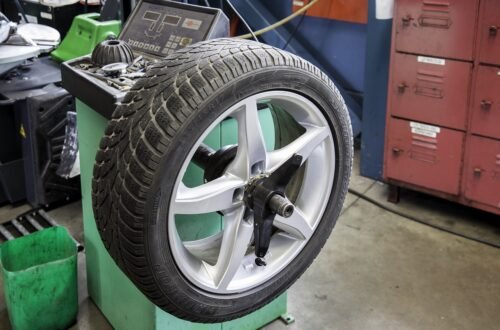Are you curious about how tire load ratings work? Look no further! In this comprehensive guide, you will gain a clear understanding of what tire load ratings are and why they matter. Whether you’re a car enthusiast or simply a responsible driver, knowing how to interpret these ratings is crucial for ensuring your safety on the road. So, let’s dive into the fascinating world of tire load ratings and equip ourselves with the knowledge we need to make informed choices when it comes to our vehicles.
What is a Tire Load Rating
Definition of Tire Load Rating
A tire load rating is a numerical code that specifies the maximum load that a tire can safely carry. It is an important aspect of tire safety and is indicated by a combination of numbers and letters on the sidewall of the tire. The load rating is typically represented as a two-digit number followed by a letter, such as 95V or 110S. The number denotes the load index, which represents the tire’s maximum load capacity, while the letter indicates the speed rating. It is essential to understand and adhere to the tire load rating to ensure optimal performance and safety of your vehicle.
Importance of Tire Load Rating
The tire load rating is crucial for several reasons. Firstly, it ensures that the weight of the vehicle and its occupants is evenly distributed among the tires, preventing excessive strain on any individual tire. Overloading a tire beyond its load rating can lead to premature tire wear, reduced handling capabilities, and even tire failure. Secondly, the load rating helps in selecting the appropriate tires for different vehicles and applications. Different vehicles have varying load requirements, and using tires with incorrect load ratings can compromise safety and performance. Therefore, understanding and adhering to the tire load rating is vital for keeping your vehicle safe on the road.
How Tire Load Ratings are Determined
Tire load ratings are determined through rigorous testing conducted by tire manufacturers. These tests involve subjecting the tires to various loads under controlled conditions. The load ratings are determined based on the maximum load a tire can carry without compromising safety and performance. The load ratings are standardized and regulated by various organizations, such as the Tire and Rim Association and the European Tyre and Rim Technical Organization. These organizations continuously update and revise load rating standards to account for advances in tire technology and to ensure consistency across different tire manufacturers.
Interpreting Tire Load Rating Markings
Understanding Load Index Numbers
The load index number on a tire indicates the maximum load capacity of the tire under specific conditions. It represents a numerical code that corresponds to a load rating on a load index chart. The load index number ranges from 0 to 279, with each number associating with a specific load capacity. For example, a tire with a load index of 95 can handle a maximum load of 1521 pounds, while a tire with a load index of 110 can carry up to 2337 pounds of weight. The higher the load index number, the greater the maximum load capacity of the tire.
Matching Load Index with Maximum Load Capacity
To ensure the safety and performance of your vehicle, it is essential to match the load index of the tire with the maximum load capacity requirements specified by the vehicle manufacturer. The vehicle manufacturer provides this information in the owner’s manual or on a placard located on the vehicle. Exceeding the load capacity specified by the manufacturer can result in tire failure, compromised handling, and increased risk of accidents. Therefore, it is crucial to select tires with load indexes that are equal to or greater than the maximum load capacity required by your vehicle.
Identifying Load Range Designations
In addition to load indexes, tires also have load range designations that provide information about their maximum load capacity. Load range designations are typically shown as letters, such as “B,” “C,” “D,” or “E,” and are often found in conjunction with the load index on the tire sidewall. Each load range corresponds to a range of load capacities, and the specific load range designation is based on the tire’s construction and intended application. It is essential to ensure that the load range of the tire matches the load range recommended by the vehicle manufacturer to ensure optimal performance and safety.

This image is property of images.pexels.com.
Factors Affecting Tire Load Ratings
Tire Construction
The construction of a tire plays a significant role in determining its load rating. Different tire designs and materials can affect the tire’s load-carrying capacity. Reinforcements, such as steel belts, sidewall plies, and fabric plies, enhance a tire’s strength and rigidity, allowing it to withstand heavier loads. Additionally, the tire’s overall design, including the tread pattern and sidewall design, can influence its load-carrying capabilities. It is important to consider the load rating when selecting tires, as different tire constructions can offer varying load capacities.
Tire Size
Tire size is another crucial factor that affects the tire’s load rating. Larger tires generally have higher load ratings, as they typically have larger contact patches and can distribute the weight over a larger area. On the other hand, smaller tires may have lower load ratings due to the limited space available for load distribution. It is important to select tires that are appropriately sized for your vehicle and can handle the maximum load requirements specified by the manufacturer.
Inflation Pressure
Proper inflation pressure is paramount for maintaining the tire’s load-carrying capacity. Underinflated tires can cause excessive heat build-up, leading to tire failure and reduced load-carrying capabilities. Overinflated tires, on the other hand, can result in a harsh ride, reduced traction, and decreased load capacity. It is crucial to regularly check and maintain the recommended inflation pressure specified by the tire manufacturer and the vehicle’s owner’s manual to ensure proper load-carrying capabilities and optimal tire performance.
Calculating Load Capacity
Load Capacity Formula
The load capacity of a tire can be calculated using a simple formula that takes into account the tire’s load index and inflation pressure. The formula is as follows:
Load Capacity = Load Index × Inflation Pressure
For example, if a tire has a load index of 95 and the recommended inflation pressure is 35 psi, the load capacity would be:
Load Capacity = 95 × 35 = 3325 lbs
This means that the tire can safely carry a maximum load of 3325 pounds.
Example Calculation
Let’s consider an example: you have a vehicle that requires tires with a load capacity of 1600 pounds each. The load index chart indicates that a load index of 92 corresponds to a load capacity of 1389 pounds. To determine the required inflation pressure, you can use the load capacity formula:
Inflation Pressure = Load Capacity ÷ Load Index
In this case, the inflation pressure would be:
Inflation Pressure = 1389 ÷ 92 = 15.11 psi
Therefore, to meet the load capacity requirements, you would need to inflate the tires to approximately 15.11 psi.

This image is property of images.pexels.com.
Determining the Right Tire Load Rating for Your Vehicle
Consulting Your Vehicle Owner’s Manual
The first step in determining the appropriate tire load rating for your vehicle is to consult the owner’s manual. The owner’s manual typically provides information regarding the recommended tire size and load rating based on the vehicle’s weight and intended usage. It may also specify any specific requirements or restrictions for tire load ratings. By following the manufacturer’s recommendations, you can ensure that your vehicle is equipped with tires that can safely carry the weight of the vehicle and its occupants.
Considering Vehicle Weight and Usage
In addition to the owner’s manual, you should consider the weight of your vehicle and your typical usage. If you frequently carry heavy loads or tow trailers, you may need tires with higher load ratings to accommodate the additional weight. Similarly, if you often drive in challenging terrains or adverse weather conditions, tires with higher load ratings can provide added stability and safety. By assessing your vehicle’s weight and intended usage, you can select tires with appropriate load ratings to ensure optimal performance and safety.
Seeking Professional Advice
If you are unsure about the appropriate tire load rating for your vehicle, it is always recommended to seek professional advice. Tire specialists, such as tire dealers or automotive technicians, can provide expert guidance based on your vehicle’s specifications and intended usage. They can help you determine the optimal tire load rating and recommend suitable tire options that meet your requirements and preferences. Seeking professional advice can help ensure that you make informed decisions and select the right tires for your vehicle.
Important Tire Safety Considerations
Overloading Risks and Consequences
Overloading your vehicle beyond its tire load rating can have serious consequences. The excessive weight places excessive stress on the tires, leading to increased heat build-up, tire degradation, and potential tire failure. Overloaded tires may exhibit signs of excessive wear, bulges on the sidewalls, or even blowouts. Moreover, overloading can compromise vehicle handling, braking, and stability, increasing the risk of accidents. To ensure your safety and the durability of your tires, it is crucial to never exceed the load rating specified by the manufacturer.
Effects of Underinflation or Overinflation
Maintaining proper inflation pressure is vital to ensure optimal tire performance and load-carrying capabilities. Underinflated tires have reduced load-carrying capacities and are more prone to sidewall flexing and excessive heat build-up, which can lead to tire failure. Overinflated tires, on the other hand, have reduced contact with the road surface, resulting in compromised traction, stability, and load-carrying capabilities. It is essential to regularly check and maintain the recommended inflation pressure to ensure proper tire load ratings and to avoid potential safety risks.
Potential Impact on Vehicle Handling
Tire load ratings not only affect the tire’s load-carrying capabilities but also influence the vehicle’s overall handling and performance. Overloaded tires can negatively impact steering response, cornering ability, and braking distance. The excessive weight can cause the tires to deform, resulting in reduced contact with the road surface. This can lead to unpredictable handling characteristics, increased stopping distances, and compromised vehicle stability. By adhering to the recommended tire load ratings, you can maintain optimal vehicle handling and ensure a safe driving experience.

This image is property of images.pexels.com.
Special Load Rating Requirements
Specific Load Rating Needs for Certain Vehicles
Certain types of vehicles, such as trucks or SUVs, may have specific load rating requirements due to their weight-carrying capabilities and intended usage. These vehicles are often designed to handle heavier loads or tow trailers, and as such, they require tires with higher load ratings. It is important to consider the specific load rating needs of your vehicle when selecting tires to ensure optimal performance and safety.
Load Rating Requirements for Towing
When towing trailers or other heavy loads, it is crucial to consider the additional weight being placed on the tires. Towing increases the overall weight being carried by the tires, which can exceed the load capacity of standard tires. Specialized tires with higher load ratings are often recommended for towing applications to ensure the safe and efficient transportation of the load. It is essential to consult the owner’s manual or seek professional advice to determine the appropriate load rating for towing purposes.
Load Ratings for Commercial Vehicles
Commercial vehicles, such as delivery trucks or vans, have unique load rating requirements due to their heavy loads and frequent use. These vehicles often require tires with higher load ratings to handle the additional weight and to accommodate the demands of commercial applications. Manufacturers provide specific load rating guidelines for commercial vehicles to ensure the safe transport of goods and to maintain the durability and performance of the tires. If you own or operate a commercial vehicle, it is important to adhere to these load rating requirements for optimal safety and performance.
Upgrading Tires with Higher Load Ratings
Benefits of Upgrading to a Higher Load Rating
In certain situations, upgrading to tires with higher load ratings can offer several benefits. If you frequently carry heavy loads or tow trailers, tires with higher load ratings can provide added peace of mind and safety. They can handle the increased weight more effectively and reduce the risk of tire failure or performance issues. Additionally, tires with higher load ratings often have increased durability, sidewall strength, and heat resistance, resulting in longer-lasting tires that can withstand demanding conditions.
Compatibility with Vehicle and Suspension
When considering upgrading to tires with higher load ratings, it is important to ensure compatibility with your vehicle and suspension system. Vehicles are designed to handle specific loads, and upgrading to tires with significantly higher load ratings may exceed the vehicle’s weight-carrying capabilities or place excessive strain on the suspension components. It is crucial to consult the owner’s manual or seek professional advice to determine the feasibility of upgrading to higher load-rated tires and to ensure compatibility with your vehicle.
Considerations for Off-Road or Modified Vehicles
Off-road vehicles or vehicles with aftermarket modifications often require specialized tires with higher load ratings to accommodate the unique demands of off-road driving or additional equipment. These tires are designed to withstand rough terrains, provide enhanced traction, and handle the additional weight of modifications. If you own an off-road vehicle or have made aftermarket modifications to your vehicle, it is important to select tires with appropriate load ratings to ensure optimal performance, safety, and durability.
Understanding Load Index vs. Load Range
Distinguishing Load Index and Load Range
While both load index and load range provide information about a tire’s maximum load-carrying capacity, they represent different aspects of tire performance. The load index is a numerical code that corresponds to the tire’s load-carrying capacity, as discussed earlier in this article. On the other hand, the load range is a letter designation that indicates the tire’s construction and intended application. Load range letters, such as “B,” “C,” “D,” or “E,” represent varying load capacities and are often found in conjunction with the load index on the tire sidewall.
Relationship between Load Index and Load Range
There is a relationship between the load index and load range, as they both provide information about the tire’s load-carrying capacity. However, it is important to note that the load range designation alone does not specify the exact load capacity. The load range designation represents a range of load capacities for a specific tire construction and application. The load index, on the other hand, provides a specific numerical value that corresponds to a specific load capacity. Both load index and load range should be considered when selecting tires to ensure they meet the load requirements of your vehicle.
Determining Appropriate Rating for Your Needs
To determine the appropriate tire load rating for your needs, it is important to consider both the load index and load range recommendations provided by the tire manufacturer and the vehicle manufacturer. These recommendations are based on the specific vehicle weight and intended applications. By selecting tires that meet both the load index and load range requirements, you can ensure that the tires can safely carry the weight of your vehicle and meet your performance needs.
Regular Tire Maintenance
Checking and Maintaining Proper Inflation Pressure
Regular tire maintenance is essential for optimal tire performance, safety, and load-carrying capabilities. One of the most critical maintenance tasks is regularly checking and maintaining proper inflation pressure. Underinflated or overinflated tires can compromise load-carrying capacities and tire performance. It is recommended to check the tire pressure at least once a month, using a reliable tire pressure gauge. The recommended inflation pressure can be found in the vehicle owner’s manual or on a placard located on the vehicle. By maintaining proper inflation pressure, you can ensure that the tires are operating within their recommended load ratings.
Monitoring Tire Wear and Tread Depth
Monitoring tire wear and tread depth is another important aspect of tire maintenance. Worn-out or bald tires have reduced load-carrying capabilities and compromised traction, which can affect the vehicle’s performance and safety. It is crucial to regularly inspect the tires for signs of wear, such as uneven tread wear, bulges, or cuts in the sidewall. Additionally, checking the tread depth using a tread depth gauge can help determine if the tires meet the legal requirements and provide sufficient traction. Tire replacement should be considered when the tread depth falls below a safe level or when there are signs of significant wear.
Periodic Inspections and Alignment
Periodic tire inspections and alignments are also necessary for maintaining optimal tire load ratings. Inspections should include checking for any signs of damage, such as punctures or sidewall cracks, as well as ensuring that the tires are properly mounted and balanced. Regular tire rotations can also help distribute the load evenly and prevent uneven wear. Additionally, wheel alignment should be performed periodically to ensure that the tires are aligned correctly, reducing uneven wear and maintaining optimal vehicle handling and stability. By incorporating these maintenance practices, you can help extend the life of your tires and ensure their load-carrying capabilities.
In conclusion, understanding tire load ratings is crucial for ensuring the safety and performance of your vehicle. The load rating provides valuable information about the tire’s maximum load-carrying capacity and is determined through rigorous testing conducted by tire manufacturers. Interpreting tire load rating markings involves understanding load index numbers, matching load index with maximum load capacity, and identifying load range designations. Factors affecting tire load ratings include tire construction, tire size, and inflation pressure. Calculating load capacity involves using a simple formula based on the load index and inflation pressure. Determining the right tire load rating for your vehicle involves consulting the vehicle owner’s manual, considering vehicle weight and usage, and seeking professional advice if needed. There are important tire safety considerations, including the risks of overloading, the effects of underinflation or overinflation, and the potential impact on vehicle handling. Special load rating requirements exist for certain vehicles, towing, and commercial vehicles. Upgrading to tires with higher load ratings can offer benefits but requires compatibility with the vehicle and suspension. Understanding the difference between load index and load range is key, and regular tire maintenance is essential, including checking and maintaining proper inflation pressure, monitoring tire wear and tread depth, and periodic inspections and alignments. By following these guidelines and understanding tire load ratings, you can ensure the safety, performance, and longevity of your tires.





